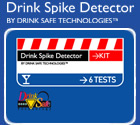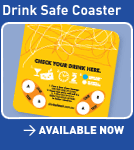GHB
Report
Reports The Detection of Gamma-Hydroxybutyrate (GHB)
Dr. Brian R. Glover and Xei Wong
September 23, 2002
ABSTRACT: The clandestine placement
of illicit chemicals into beverages for the purpose
of sexual assault is a growing concern throughout the
world. With the increasing availability of so called
‘club drugs’ like Gamma-Hydroxybutyrate
(GHB), a quick, simple and reliable means to qualitatively
ascertain the presence of these entities in both alcoholic
and non-alcoholic beverages in a social setting is necessary.
Utilizing Drink Safe Technologies TM colorimetric chemical
indicator technology, Gamma-Hydroxybutyrate (GHB) was
tested in 28 common beverages, at varying concentrations.
Accurate identification was confirmed in all beverages.
Introduction
Gamma-Hydroxybutyrate (GHB) is an endogenous metabolite
found in human metabolism which shares a similar structure
common to the neurotransmitter Gamma-Aminobutyric acid
(GABA) (1,2). It was first synthesized and used in Europe
as an anesthetic in the 1960’s, but it’s
use was later discontinued because it lacked analgesics
properties, and side effects of petit mal and grand
mal seizures as well as comma were often reported (3).
Primarily a central nervous system depressant, adverse
effects reported include a large range of clinical features
including relaxation, confusion, nausea, agitation and
short-term amnesia. Larger doses can lead to respiratory
depression, hallucinations and unarousable unconsciousness
(3-8). These effects are synergistic with ethanol, making
it even more dangerous.
GHB abuse has statistically grown over the last decade
as the availability has increased. Data from the Drug
Abuse Warning Network (DAWN) indicate that the number
of emergency room department mentions increased by almost
5000 % from 1994 to 2000 (9) GHB can easily be made
in amateur laboratories following simple recipes utilizing
ingredients found and purchased on the internet as well
as local health food stores.
Available as either a clear liquid or white powder
easily made into tablet or capsule form, GHB has earned
the sinister distinction of being the ‘date rape’
drug of choice. This is primarily due to the drug’s
intrinsic qualities. When placed into a consumable beverage,
it imparts little to no discernable taste, no aroma
and is relatively undetectable to visual inspection.
But it is the ability to render a person in a semi-comatose
state after ingestion that makes it a key agent in many
drug facilitated sexual assaults.
Relative drug concentrations of GHB used for the purpose
of drug-facilitated sexual assault are open to discussion.
Matilla et al (1978) concluded in a study of the effects
of GHB and alcohol that oral doses of 1 to 2 grams of
GHB had little increase in the effects of low doses
of ethanol (10). Typically, GHB users will orally ingest
in excess of 1 teaspoon, which is equivalent to at least
2.5 grams, 35 mg/kg for a 70 kg person (3,5). In another
study, subjects were given a single dose of 30 mg/kg
orally. Symptoms reported were sluggishness, fatigue
and a feeling of being dazed, drunk and carefree (11).
These same symptoms were not reported in placebo control
groups. Doses above 50 mg/kg, or about 3.5 grams for
a 70 kg individual, resulted in transient unconsciousness,
hypotonia, bradycardia and decreased respiration (4,6,8).
Anecdotal accounts of federal and local law enforcement
has yielded a rule of thumb being that most would be
perpetrators of this act will dispense one to two full
capfuls of GHB as measured into a typical soda bottle
cap and placed in an 8 ounce beverage. One capful equals
about 2 teaspoons of liquid GHB, therefore a typical
dosing can range from 5.0 grams to over 10 grams. Most
victims will feel the effect s before they ever finish
the full 8 ounce beverage, thereby receiving a potentially
lethal dose, but deaths have been reported.
Previously, there had not been a qualitative field
assay, which was simple, reliable and efficient as well
as being discrete so as to have large public acceptance.
The purposed Drink Safe Coaster TM and Drink Safe Personal
Test Strips TM utilizing Drink Safe Technologies TM
colorimetric chemical indicator technology was created
to fill this need. These easily performed tests were
designed to provide a ‘first line of defense’
against the addition of Gamma-Hydroxybutyrate (GHB)
into a consumable beverage. Using a variation of some
well documented chemical colorimetric indicators, like
platinum iodide or Zimmermann’s reagent, this
patent-pending technology was created to have a high
affinity for Gamma-Hydroxybutyrate (GHB) complexed with
either sodium or potassium as the associated cation.
Method
Drink Safe Technologies TM colorimetric chemical indicator
technology version 1.2 was applied to unbleached, ph
balanced, sodium free test paper. Four test spots were
created per beverage to be tested, three for the varying
concentrations, and one for a control. Sodium Gamma-Hydroxybutyrate
(NaGHB) powder was obtained and measured into 2.0 gram,
3.0 gram and 4.0 gram doses. Each was placed into the
30 selected beverages, which were chosen as being indicative
of typical public consumption. A control beverage of
each was tested for false positives. The beverages tested
were measured to be room temperature, 25° C +/-
1° C. All beverages were stirred until all solid
particles were incorporated into solution. Test responses
were interpreted in adequate natural light, and with
holding the test paper up to the light source when necessary
for further clarification. A droplet of each beverage
using a glass stirring rod was placed upon each test
spot, smeared lightly, and allowed to dry. The list
of beverages selected were as follows:
Non-Alcoholic Beverages:
Coca-Cola, Diet Coke, Pepsi, Diet Pepsi, 7-Up, Coffee-plain,
Tea-plain, Snapple Ice Tea-regular, Snapple Ice Tea-diet,
Dansi bottled water, Gatorade-green.
Alcoholic Beverages:
Budweiser beer, Miller Lite beer, Coors Light beer,
Amstel Light beer, Cabernet Sauvignon California wine-Vendange
(2000), Chardonnay California wine-Vendange (2000),
Feischmano’s vodka, Seagram’s-7 whiskey,
Jack Daniels whiskey, Bacardi rum-Carta Blanca, Cuervo
Gold tequila, Rum and Coke (Bacardi with Coca Cola),
Margarita (Cuervo Gold), Bloody Mary (Feishmano Vodka).
Results
All beverages tested gave positive results with all
3 concentrations dispensed, within 3 minutes elapsed
time. Higher concentrations of drugs gave a quicker
and slighter brighter blue result than lesser concentrations.
Beverages with an intrinsic darker color took more effort
to interpret, with Cabernet Sauvignon wine being the
most difficult, and the Bloody Mary drink being second.
It should be noted that appropriate lighting conditions
are necessary, and holding the test area up to a light
source to let the light pass through the paper, greatly
helps with harder to interpret results.
It should also be noted that although bottled water
performed adequately in terms of true positive and true
negative results, some tap water from different areas
will have a tendency to give a false negative ‘hallow’
effect which sometimes will dissipate upon drying and
sometimes not. This effect, primarily due to heavy metal
ions within the samples, should be noted.
Conclusions
Detection of beverages tainted with Gamma-Hydroxy butyrate
(GHB) utilizing colorimetric chemical indicators is
a promising tool in the fight against drug facilitated
sexual assault. Common sense dictates that a level of
interpretation by the operator is in order, and discretion
should always be followed with regards to the results.
Adequate lighting is very important, and it is unfortunate
that many social settings where the test would be most
effective are generally devoid of this.
No one method or technology should be relied upon exclusively.
The tried and true advice of watch your drink, don't
leave it unattended, go out in groups and when in doubt
don't consume, is still the single best combat against
drug facilitated sexual assault.
References
1. Ferra SD. et al. J of Pharm and Biomed
Anal 1993; 11:483-7.
2. Adornato B. and TSE V. Western J of Med 1995; 92:354-7.
3. Dyer JE. g-hydroxybutyrate: A health food product
producing coma and seizure-like activity. Am J Emerg
Med
1991; 9:321-4.
4. Pallatini P. Tedeschi L. Frison G. Padrini R. Zordan
R. Orlano R. et al. Dose-dependent absortion and
elimination of gamma-hydroxybutyric acid in healthy
volunteers. Eur J Clin Pharmacol 1993; 45:353-6
5. Galloway GP. Fredrick SL. Staggers FE Jr. Gonzales
M. Stalcup SA. Smith DE. Gamma-hydroxybutyrate: an
emerging drug of abuse that causes physical dependence.
Addiction 1997; 92(1)c89-96.
6. Chin M-Y. Kneuzer RA. Dyer JE. Acute poisoning from
g-hydroxybutyrate in California. West J Med 2000;
156: 380-4.
7. Li J. Stokes SA. Woeckemer A. A tale of novel intoxication:
a review of the effects of g-hydroxybutyric acid
with recommendations for management. Ann Emerg Med 1998b;
31(6): 729-36.
8. Baselt RC. Cravey RH. Disposition of toxic drugs
and chemicals in man. 5th ed. Foster City, CA: Chemical
Toxicology Institute, 2000;386-8.
9. National Drug Intelligence Center, U.S. Department
of Justice, National Drug Threat Assessment 2002;table
A9: 80
10. Matilla MJ. Palva E. Sepälä T. Ostrovskaya
RU. Actions and interactions with alcohol of drugs on
psychomotor skills: comparison of diazepam and g-hydroxybutyric
acid. Arch Int Pharmacodyn 1978; 234;
236-46.
11. Rosen MI. Pearsall HR. Woods SW. Kosten TR. Effects
of gamma-hydroxybutyric acid (GHB) in opiod-
dependent patients. J Subst Abuse Treat 1997; 14(2);
149-54. |

